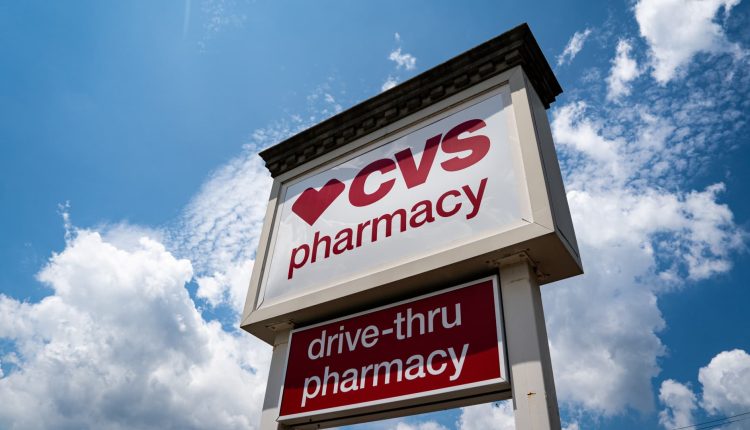Signage for a CVS Pharmacy in Takoma Park, Maryland, USA, on Wednesday, July 9, 2025.
Al Drago | Bloomberg | Getty Images
CVS Health reported third-quarter earnings and revenue on Wednesday that beat estimates and raised its adjusted earnings outlook as the company sees strength in its insurance division and retail pharmacy business.
Still, shares of CVS fell more than 3% in premarket trading on Wednesday as the company posted a net loss for the quarter due to a $5.7 billion goodwill impairment charge related to the Health Services segment’s Health Services reporting unit.
The quarterly results cap David Joyner’s first full year as CEO of the company, which struggled to deliver higher profits and improve stock performance under its last top executive, Karen Lynch. Joyner’s aggressive efforts to turn around the struggling drugstore chain – from executive shuffles to cost cuts – already appear to be paying off, with shares up more than 85% for the year.
The company now expects fiscal 2025 adjusted earnings of $6.55 to $6.65 per share, up from previous guidance of $6.30 to $6.40 per share. CVS has now raised its outlook for the third time in a row.
“[I] We couldn’t be happier that we beat and raised in three quarters, and obviously looking forward to the fourth quarter, we feel very, very good that we can finish the year on a positive note,” Joyner said in an interview.
He pointed to several factors, including the recovery at Aetna, the company’s insurer. Aetna and other insurers have struggled with higher-than-expected medical costs over the last year as more Medicare Advantage patients return to hospitals for procedures they had postponed during the pandemic. While medical costs remain high, Aetna and other insurers such as UnitedHealthcareappear to be better equipped to deal with the problem in the future.
Joyner also highlighted a “really good selling season” for its pharmacy benefit manager Caremark and goodwill impairment related to its healthcare delivery reporting unit.
Here’s what CVS reported for the third quarter compared to Wall Street’s expectations, based on an analyst survey from LSEG:
- Earnings per share: $1.60 adjusted vs. $1.37 expected
- Revenue: $102.87 billion versus expected $98.85 billion
The company reported a third-quarter net loss of $3.99 billion, or $3.13 per share. By comparison, net income was $71 million, or 7 cents per share, in the same period last year.
In a news release, CVS said the loss reflected the impairment of goodwill related to its health care reporting unit, which “continued to face challenges that impacted its ability to grow the business at the previously estimated pace.” The company made several changes to the segment’s management team and completed strategic changes, including plans to reduce the number of primary care clinics scheduled to open in 2026 and beyond.
“We actually made the decision this quarter to both slow clinic growth and close some of the underperforming clinics,” Joyner said. He noted that CVS has announced it will close 16 locations of primary care provider Oak Street Health.
However, Joyner said, “This does not change our view of value-based care,” noting that Oak Street Health is “actually operating according to plan.”
Excluding certain items such as amortization of intangible assets, restructuring costs and capital losses, adjusted earnings for the quarter were $1.60 per share.
CVS reported third-quarter revenue of $102.87 billion, up 7.8% from the same period last year, as all three divisions grew. According to StreetAccount estimates, Wall Street expected CVS to reach more than $100 billion in quarterly sales only in the fourth quarter.
Growth across all business areas
All three of CVS’s divisions beat Wall Street’s third-quarter sales expectations, with notable improvements in its insurance business.
The insurance segment’s medical benefit ratio – a measure of total medical costs paid relative to premiums collected – fell to 92.8% from 95.2% a year ago. A lower ratio typically indicates that a company has collected more in premiums than it has paid out in benefits, leading to higher profitability.
This ratio is slightly higher than the 92.4% expected by analysts, according to StreetAccount.
CVS said this was due to, among other things, the “favorable year-over-year impact of premium loss reserves recorded as health care costs” and improved underlying performance in the insurance unit’s government business. Loss of premium reserves are a liability that an insurer may need to cover if future premiums are insufficient to cover expected claims and costs.
Aetna’s government business serves plans including Medicare Advantage and Medicare Prescription Drug or Part D plans.
The insurance business posted revenue of $35.99 billion in the quarter, up more than 9% from the third quarter of 2024. Analysts expected the division to bring in $34.48 billion in the period, according to StreetAccount estimates.
CVS said growth was driven by increases in government business, largely due to the impact of the Inflation Reduction Act on the Medicare Part D program. Provisions of this law have contributed to increases in some Medicare Part D premiums.
CVS’ pharmacy and consumer wellness division reported third-quarter sales of $36.21 billion, up 11.7% from the same period last year.
CVS said the increase was partly due to higher prescription volume, including the company’s acquisition of prescriptions from Rite Aid, but was offset by reimbursement pressures at pharmacies. According to StreetAccount, analysts expected revenue of $35.6 billion for the quarter.
This unit dispenses prescriptions at CVS’s more than 9,000 retail pharmacies and provides other pharmacy services such as vaccinations and diagnostic testing.
CVS’s healthcare services segment generated revenue of $49.27 billion in the quarter, up 11.6% compared to the same quarter in 2024. Analysts expected revenue of $45.71 billion for the period, according to StreetAccount.
This unit includes Caremark, which negotiates drug discounts with manufacturers on behalf of insurance plans, creates lists of drugs or prescription lists covered by insurance, and reimburses pharmacies for prescriptions.
— CNBC’s Bertha Coombs contributed to this report


Comments are closed, but trackbacks and pingbacks are open.